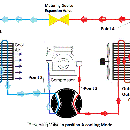Introduction: Welding Table
This is a welding table that I designed with inspiration from many different tables that I found on a variety of sites. I wanted a table that would be easy and inexpensive to build, have clamp access anywhere on the top, and have a flat working surface. This is what I came up with! It is made from 11 gauge (1/8") rectangular tubing in three sizes: 6" x 2", 3" x 2", and 2" x 2". I decided to use 6" x 2" tube because it was much less expensive and 24 times as stiff as 6" x 2" x 1/2" plate. I bolted the working surface onto the frame to keep it from bending during welding and so I could easily replace them if needed.
The metal cost about $250 and the casters were about $60.
This complete table is available in Google Sketchup.
Step 1: Make the Working Surface Sub-frame
Spacer plates are cut, drilled, and tapped to 1/2"-13. I used a jig to position the spacers when drilling the holes. I put an "x" in the same corner of each spacer so I could keep them oriented the same way during assembly. This will help minimize production errors.
Check the main sub-frame beams for straightness. If they are bent at all, drill the holes on the side with largest radius (the "outside" of the bend). Drill 3/4" holes where the spacer plate holes will be when welded onto the beam. The over-sized holes in the beam ensure that there will be no material blocking the bolts that go through the spacer plates.
Drill two 1/2" holes in piece of scrap metal 7-1/2" apart. You will use this as a placement guide for the spacer plates. Precisely position the first spacer plate on the beam and tack weld it into place. Thread a 1/2"-13 bolt through one hole in the guide and into the tack welded spacer plate. Position the open hole in the guide over the next hole in the beam. Place a spacer between the beam and guide. Thread another bolt through the guide and into the spacer. Center the spacer on the beam and tack weld into place. Continue this process with the rest of the spacers. Using the guide will ensure that the holes in the spacers are exactly the same distance from each other.
Repeat for the second sub-frame beam.
Step 2: Check Beams for Straightness
Welding the spacers onto the beam will mostly likely cause some bending. Place a straight edge long enough to cover all the spacers on top of the beam. I had about an 1/8" gap in the middle. Using some chain and a hydraulic jack, I bent the beams back to "pretty straight". A hydraulic press would have been easier to use, but I don't have one. You can see in the last picture that there is almost no gap between the spacers when the beams are laid on top of each other. I measured the gap at .018". That's straight enough for me!
Step 3: Prepare and Assemble the Working Surface
Cut the working surface pieces to length. Drill 1/2" holes on one side, centered 4" from the ends. Ensure these pieces are flat! If any are bent, discard them (or try to bend them so they are flat). The flatness of the working surface depends on two things: the flatness of the main sub-frame beams, and the flatness of the working surface pieces.
The next part is a little tricky. Using 1" long 1/2"-13 bolts, bolt all the working surface pieces to the sub-frame beams. Ensure everything is square, then snug up the bolts. Ensure everything is square again, and then tack weld in the sub-frame cross braces. If everything is still square and flat, you're good to go!
Step 4: Weld on the Legs and Cross Braces
Nothing complicated here. Just make sure everything is square! These are all 2" x 2" square tube. 1" round tube is used for the tool hangars (I used EMT). I positioned the top of the round tube 3-1/2" down from the surface above.
Step 5: Weld in the Shelf
I cut the expanded metal shelf about 1" oversized in both directions. I then folded up 1/2" on each side (cut out the corners). Ensure the top of the mesh is flush with the top of the braces and weld into place.
Step 6: Prepare Feet and Attach Casters
I welded 1/2"-13 nuts onto 2" x 2" x 1/8" plates. Be sure to drill a 5/8" hole in the center of the plates before the nuts are welded on. The plates where then welded onto the legs. Obviously, use nuts that are the same as the threads on your casters. I used 4" stem casters with wheel locks, rated at 350# each.
Step 7: Make Wooden Top and Electrical Box
I decided to make a removable wooden top so I could use this welding table as a workbench, too! It's 1" plywood with a couple 2" x 4"s attached to it. I used two sheets of 1/2" plywood because that's what I had laying around. I had to plane down the 2" x 4"s a little so they would fit in the gaps of the working surface.
The electrical box is a four-gang box with an extension cord coming out of it. I screwed it onto one of the beams.
That's it! Good luck and let me know if you have any questions!
Happy welding!













